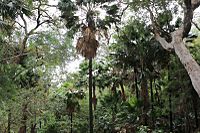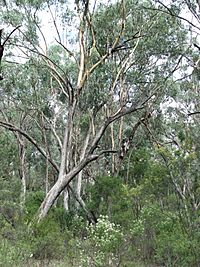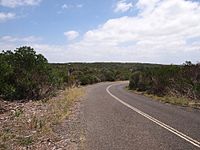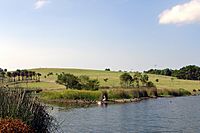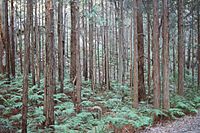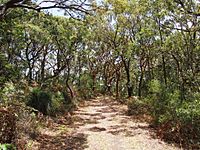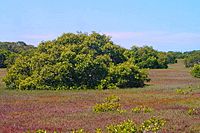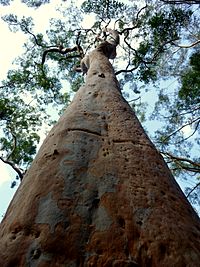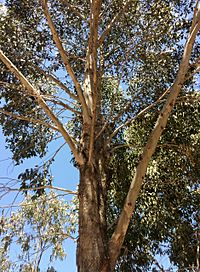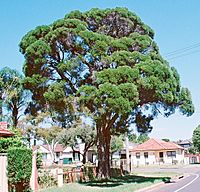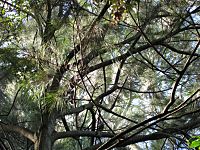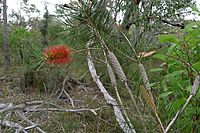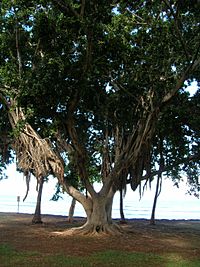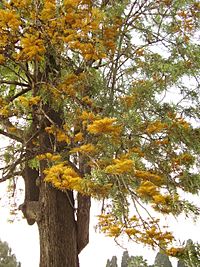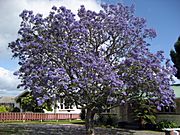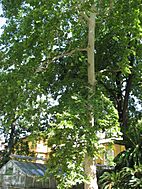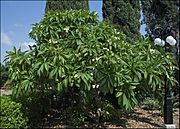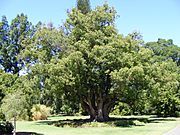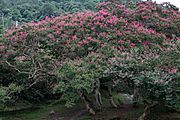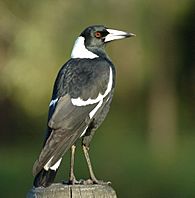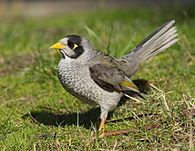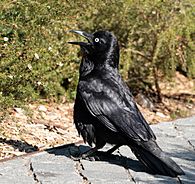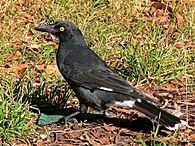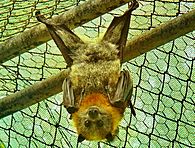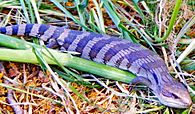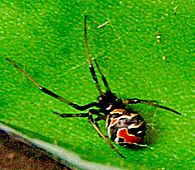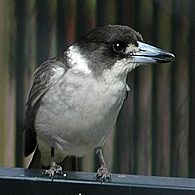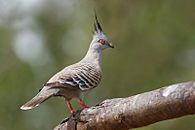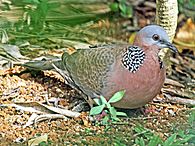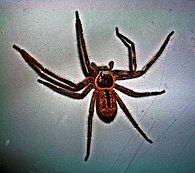Ecology of Sydney facts for kids
The ecology of Sydney is all about the amazing plants and animals that live in and around the big city of Sydney, New South Wales, Australia. Even though it's a huge city, Sydney has many different natural areas, like woodlands with lots of trees, sclerophyll forests (which have tough, spiky-leaved plants), and even small patches of rainforests, heathlands, and wetlands.
These different natural areas exist because of Sydney's weather, land shape, moisture, and soil. You can find these communities from sea level all the way up to 200 meters (about 650 feet) high! There are lots of hiking trails and roads to explore these cool ecosystems.
The most common type of natural area in Sydney is the grassy woodland. You'll mostly find this west of the city center, in a place called the Cumberland Plain. Here, you'll see lots of eucalyptus trees that are spread out, with some shrubs like wattles, callistemons, grevilleas, and banksias underneath. The ground usually has sparse grass. These plants often have rough, spiky leaves because the soil isn't very rich.
Wet sclerophyll forests are different. They have tall, dense trees and a lush, moist understory with soft shrubs and tree ferns. These are found in wetter areas, like the Forest District and the North Shore.
For example, the Sydney Turpentine-Ironbark Forest is a type of dry sclerophyll forest. Its trees grow 20–30 meters (65–100 feet) tall, and the ground is covered with flowering shrubs and native grasses. The Blue Gum High Forest, found only in northern Sydney, is a wet sclerophyll forest. It gets over 1100 mm (43 inches) of rain each year, and its trees can reach 20 to 40 meters (65–130 feet) tall!
Today, about 98,000 hectares (242,000 acres) of native plants are left in the Sydney area. That's about half of what was here before Europeans arrived.
Contents
Sydney's Past Landscapes
In 1819, an early British settler named William Wentworth wrote about Sydney's land and plants. He said that close to the coast, the land was quite sandy and rocky, with only small, tough gum trees and low shrubs. But he noted that these wild heathlands had many beautiful flowering shrubs, making them interesting for plant lovers.
Further inland, the land improved. The soil became richer, and the forests had very tall trees like gums and iron barks. He described these forests as thick but without much undergrowth. Even further inland, the forests became less dense, and the trees changed to stringy barks, blue gums, and box trees.
Eventually, he found a truly beautiful country with hills and valleys covered in lush grass, where sheep and cows grazed. The soil was rich, and the trees were thinner, allowing people to ride horses easily through the open landscape.
Different Natural Areas (Biomes)
Sydney is home to many different types of natural areas, called biomes.
- Rainforests
- Subtropical rainforests – These are found in small, separate areas around Royal National Park, Helensburgh, and the Illawarra escarpment south of Sydney.
- North Coast Warm Temperate Rainforests – You can find these in places like Ku-ring-gai Chase National Park and Turramurra in northern Sydney.
- Dry Rainforests or Western Sydney Dry Rainforest – These are part of the Cumberland Plain Woodland and are found in dry areas south of the Blue Mountains.
- Littoral Rainforests – These grow close to the coast in places like Royal National Park (near Bundeena) and Towra Point Nature Reserve.
- Wet Sclerophyll Forests
- North Coast Wet Sclerophyll Forests – These forests have tall Eucalyptus saligna and Eucalyptus pilularis trees and get a lot of rain. They are in areas like Ku-ring-gai Council and Hornsby Shire in the north.
- Northern Hinterland Wet Sclerophyll Forests – Once widespread in northern Sydney, these forests are dominated by Eucalyptus resinifera and Syncarpia glomulifera.
- Sydney Turpentine-Ironbark Forest – This tall, open forest has trees up to 30 meters (100 feet) high and is found in small areas like Campbelltown.
- Grassy Woodlands
- Cumberland Plain Woodland – This is the most common type of woodland in Western Sydney. It has eucalyptus trees, shrubs, and grasses, and grows in areas with less rain.
- Dry Sclerophyll Forests
- Sydney Coastal Dry Sclerophyll Forests – These are found on ridgelines in national parks like Royal, Heathcote, and Dharawal, and along the Hawkesbury River.
- Sydney Hinterland Dry Sclerophyll Forests – These are in drier parts of the Woronora Plateau and have 10–25 meter (30–80 feet) tall eucalyptus trees with tough, spiky shrubs underneath.
- Cooks River/Castlereagh Ironbark Forest – Found in Castlereagh and Holsworthy, this forest has ironbark trees and grows on gravelly-clay soils.
- Heathlands
- Wallum Sand Heaths – These are found on sand dunes high on sandstone cliffs, like between Bundeena and the Sydney Heads. They have plants like Allocasuarina distyla and Banksia serrata.
- Sydney Coastal Heaths – These are common in Sydney, especially in Royal and Ku-ring-gai national parks.
- Freshwater Wetlands
- Castlereagh Swamp Woodland – This is a swampy forest found in low areas of Liverpool, with lots of paperbark trees.
- Coastal Heath Swamps – These are common in areas like the Holsworthy defense area and Ku-ring-gai Chase National Park.
- Forested Wetlands
- Sydney Coastal River-Flat Forest – Found along rivers and creeks, these forests have tall eucalyptus trees that can be over 40 meters (130 feet) high.
- Coastal Swamp Forests – These are in low-lying coastal areas and swamps, though many have been cleared. You can still find them in places like Georges River National Park.
- Saline Wetlands
- Mangrove Swamps – Common in Towra Point, these are dominated by mangrove trees like Avicennia marina.
- Saltmarshes – These are found on salty soils near estuaries and bays.
- Seagrass Meadows – These are underwater plant communities found in sandy parts of coastal estuaries and bays, with plants like eel grass and sea grass.
Plants of Sydney
Sydney has many different types of plants, especially eucalyptus trees.
Some of the most common eucalyptus trees in Sydney include:
- Angophora costata (Sydney red gum)
- Eucalyptus piperita (Sydney peppermint)
- Eucalyptus moluccana (grey box)
- Corymbia gummifera (red bloodwood)
- Corymbia maculata (spotted gum)
Other common native trees that are not eucalyptus include:
- Allocasuarina torulosa (forest oak)
- Melaleuca linariifolia (snow-in-summer)
- Grevillea robusta (Australian silver oak)
- Syncarpia glomulifera (turpentine tree)
- Banksia integrifolia (coast banksia)
- Brachychiton acerifolius (Illawarra flame tree)
- Ficus macrophylla (Moreton Bay fig)
- Lophostemon confertus (brush box)
Common native shrubs include:
- Banksia serrata (old man banksia)
- Casuarina glauca (swamp oak)
- Ceratopetalum gummiferum (New South Wales Christmas bush)
- Spiny-head mat-rush
- Lemon bottlebrush
Introduced Plants
Many plants have been brought to Sydney from other parts of the world. Some of these are grown for their beauty, while others have become weeds that can take over native areas.
Introduced trees you might see:
- Jacaranda mimosifolia (blue jacaranda)
- Cinnamomum camphora (camphor laurel)
- Pinus radiata (Monterey pine)
- Plumeria rubra (red frangipani)
- Liquidambar styraciflua (sweet gum)
- Platanus × acerifolia (London planetree)
Introduced shrubs (many are invasive):
- Thunbergia grandiflora (blue skyflower)
- Alternanthera philoxeroides (alligator weed)
- West Indian lantana
- Ochna serrulata (Mickey Mouse plant)
- Ligustrum sinense (small-leaved privet)
- Introduced tree species
-
Jacarandas are widely grown as ornamental trees.
-
The London plane is used extensively as a street tree in Sydney suburbs.
-
Monterey pines were introduced to Sydney in the 1870s.
-
Frangipani is widely seen in cultivation in Sydney.
-
Camphor laurel was introduced to Australia in 1822.
-
Native to eastern Asia, crepe myrtles are common ornamental trees in suburban streets.
Wildlife of Sydney
Sydney's urban areas are home to many different animals, especially birds and insects. You might also see some bats, arachnids (like spiders), and amphibians (like frogs). Birds like the house sparrow, common myna, and feral pigeon are very common in the city center. In suburban areas, you might spot possums, bandicoots, lizards, snakes, and frogs.
About 40 types of reptiles and 30 types of birds live in Sydney's urban areas. The outer suburbs, especially near large parks, have even more diverse wildlife. Sadly, since European settlement, about 60% of the original mammal species are now endangered or vulnerable due to land clearing.
Animals You Might See
Here are some common birds you might see in Sydney:
- Australian magpie
- Australian raven
- Australian white ibis
- Crested pigeon
- Eastern rosella
- Galah
- Laughing kookaburra
- Noisy miner
- Rainbow lorikeet
- Sulphur-crested cockatoo
- Willie wagtail
Less commonly spotted, but still present:
- Australian king-parrot
- Eastern yellow robin
- Little wattlebird
- New Holland honeyeater
- Tawny frogmouth
- White-bellied sea-eagle
Here are some mammals, reptiles, and amphibians you might spot in Sydney's urban areas:
- Australian blue-tongued skink
- Australian green tree frog
- Australian water dragon
- Common brushtail possum
- Common ringtail possum
- Eastern brown snake
- Grey-headed flying fox
- Long-nosed bandicoot
- Red-bellied black snake
- Squirrel glider
Insects and Spiders
Here are some insects and spiders commonly found in Sydney:
- Australian garden orb weaver spider
- Black house spider
- Christmas beetle
- Green-head ant
- Sydney huntsman spider
- Redback spiders
- Sydney funnel-web spider
- Transverse ladybird
Images for kids
-
Royal Botanic Garden, with palm trees and subtropical vegetation.
-
The Hawkesbury valley, covered in frost.


